PayPal Payments Standard
PayPal Payments Standard is the easiest way to accept payments online. You can offer your customers the convenience of payment both by credit card and PayPal by simply adding a checkout button to your store.
For merchants outside the US, this is called PayPal Website Payments Standard.
With PayPal Payments Standard, you can swipe credit cards on mobile devices. There is no monthly fee and you can get paid through eBay. Supported credit cards include Visa, MasterCard, Discover, and American Express. In addition, customers can pay directly from their personal PayPal accounts. PayPal Payments Standard is available in all countries on the PayPal worldwide reference list.
Payment Services Directive Requirements:
As of September 14, 2019, European banks might decline payments that do not meet PSD2 requirements. No action is needed for PayPal Payments Standard to comply with PSD2 because all requirements are handled by PayPal.
Merchant requirements
Checkout workflow
For customers, PayPal Payments Standard is a one-step process if the credit card information the their personal PayPal accounts is up to date.
| 1 | Customer Places Order | The customer clicks/taps the Pay Now button to complete the purchase. |
| 2 | PayPal Processes the Transaction | The customer is redirected to the PayPal site to complete the transaction. |
Set up PayPal Payments Standard
PayPal Payments Standard cannot be used simultaneously with any other PayPal method, including Express Checkout. If you change payment solutions, the one used previously is disabled.
Click Save Config at any time to save your progress.
Step 1: Begin the Magento configuration
This setup method assumes you have an existing PayPal account.
-
On the Admin sidebar, go to Stores > Settings > Configuration.
-
In the left panel, expand Sales and choose Payment Methods.
-
If your Magento installation has multiple websites, stores, or views, set Store View to the store view where you want to apply this configuration.
-
In the Merchant Location section, select the Merchant Country where your business is located.
This setting determines the selection of PayPal Solutions that appear in the configuration.
 Merchant Country
Merchant Country -
Expand PayPal All-in-One Payment Solutions and click Configure for Payments Standard.
 Payments Standard
Payments Standard
Step 2: Enable and connect your PayPal account
 Payments Standard - configuration
Payments Standard - configuration
-
Connect your account for test or production:
- For testing (development) mode, click Sandbox Credentials and enter your PayPal sandbox credentials.
- For production mode, click Connect with PayPal and enter you production account credentials.
When your connection is validated, you can proceed.
-
Set Enable This Solution to
Yes. -
If you want to offer PayPal Credit to your customers, set Enable PayPal Credit to
Yes.
Step 3: Complete the Payments Standard settings
-
Expand
 the Payments Standard section.
the Payments Standard section.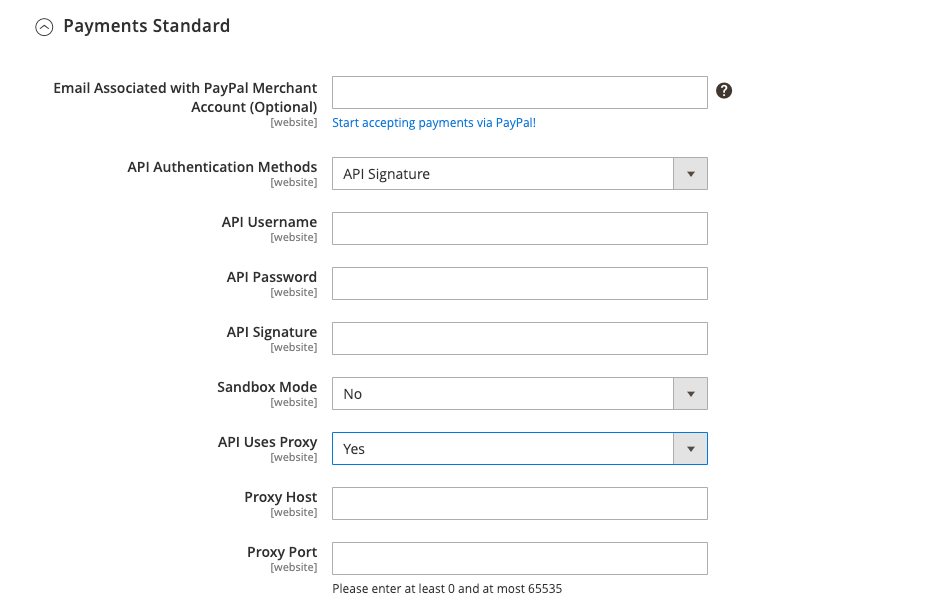 Payments Standard settings
Payments Standard settings -
Enter the Email Associated with your PayPal Merchant Account.
Email addresses are case sensitive. To receive payment, the email address you enter must match the email address specified in your PayPal merchant account.
If you do not have a PayPal account, click Start accepting payments via PayPal.
-
Set API Authentication Methods to one of the following:
API SignatureThis PayPal authentication method is the easiest to implement, and is based on your user name, password, and a unique string of characters and numbers that identifies your account. API Signature credentials do not expire. API CertificateThis PayPal authentication method is more secure, is based on your user name, password, and a downloadable certificate. API Credentials expire after three years, and must be renewed. If necessary, complete the following:
- API Username
- API Password
- API Signature
-
If you are using credentials from your sandbox account, set Sandbox Mode to
Yes.When testing the configuration in a sandbox, use only credit card numbers that are recommended by PayPal. When you are ready to go live, return to the configuration and set Sandbox Mode to
Noand connect to your production PayPal account. -
If your system uses a proxy server to establish the connection between Magento and the PayPal payment system, set API Uses Proxy to
Yesand complete the following:- Proxy Host
- Proxy Port
Step 4: Set up Advertise PayPal Credit (optional)
-
Expand
 the Advertise PayPal Credit section.
the Advertise PayPal Credit section. Advertise PayPal Credit - Home Page
Advertise PayPal Credit - Home Page -
Click Get Publisher ID from PayPal and follow the instructions to get your account information.
-
Enter your Publisher ID.
 Advertise PayPal Credit
Advertise PayPal Credit -
Expand
 the Home Page section.
the Home Page section. -
To place a banner on the page, set Display to
Yes. -
Set Position to one of the following:
Header (center)Sidebar (right)
-
Set Size to one of the following:
190 x 100234 x 60300 x 50468 x 60728 x 90800 x 66
-
Expand
 the remaining sections and repeat the previous steps:
the remaining sections and repeat the previous steps:- Catalog Category Page
- Catalog Product Page
- Checkout Cart Page
Step 5: Complete the basic settings
-
Expand
 the Basic Settings - PayPal Website Payments Standard section.
the Basic Settings - PayPal Website Payments Standard section.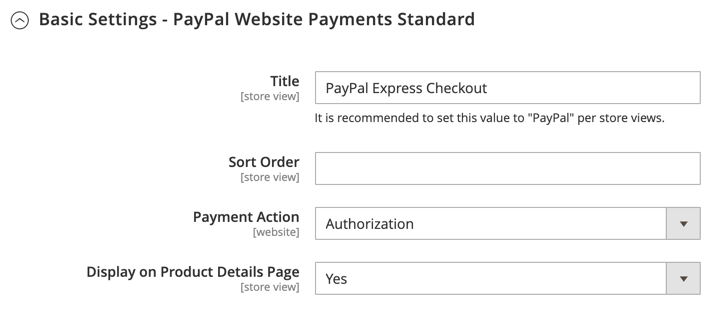 Basic Settings - PayPal Website Payments Standard
Basic Settings - PayPal Website Payments Standard -
Enter a Title to identify this payment method during checkout.
It is recommended that you use the title PayPal for all store views.
-
If you offer multiple payment methods, enter a number for Sort Order to determine the sequence in which PayPal Payments Standard appears when listed with the other payment methods.
This is relative to the other payment methods. (
0= first,1= second,2= third, and so on.) -
Set Payment Action to one of the following:
AuthorizationApproves the purchase and puts a hold on the funds. The amount is not withdrawn until it is captured by the merchant. SaleThe amount of the purchase is authorized and immediately withdrawn from the customer’s account. -
To display the Check out with PayPal button on the product page, set Display on Product Details Page to
Yes.
Step 6: Complete the advanced Settings
-
Expand
 the Advanced Settings section.
the Advanced Settings section.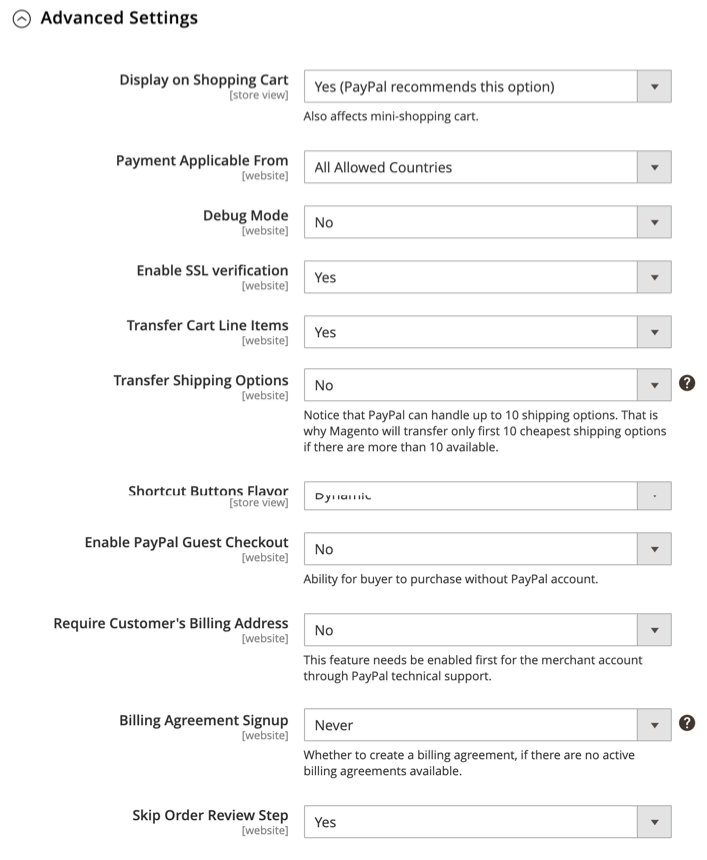 Advanced Settings - PayPal Website Payments Standard
Advanced Settings - PayPal Website Payments Standard -
To make PayPal Payments Standard available from both the shopping cart and mini cart, set Display on Shopping Cart to
Yes. -
Set Payment from Applicable Countries to one of the following:
All Allowed CountriesCustomers from all countries specified in your store configuration can use this payment method. Specific CountriesAfter you choose this option, the Payment from Specific Countries list appears. To select multiple countries, hold down the Ctrl key (PC) or the Command key (Mac) and click each option. -
To record communications with the payment system in the log file, set Debug Mode to
Yes.The log file is stored on the server and is accessible only to developers. In accordance with PCI Data Security Standards, credit card information is not recorded in the log file.
-
To enable SSL verification, set Enable SSL verification to
Yes. -
To display a summary of each line item in the order on your PayPal payments page, set Transfer Cart Line Items to
Yes.To include up to 10 shipping options in the summary, set Transfer Shipping Options to
Yes. (This option appears only if line items are set to transfer.) -
To determine the type of image that is used for the PayPal acceptance button, set Shortcut Buttons Flavor to one of the following:
Dynamic(Recommended) Displays an image that can be dynamically changed from the PayPal server. StaticDisplays a specific image that cannot be dynamically changed. -
To allow customers who do not have a PayPal account to make a purchases with this method, set Enable PayPal Guest Checkout to
Yes. -
Set Require Customer’s Billing Address to one of the following:
YesRequires the customer billing address for all purchases. NoDoes not require the customer billing address for any purchases. For Virtual Quotes OnlyRequires the customer billing address for virtual quotes only. -
To determine if the customer can enter into a billing agreement with your store in the PayPal payment system when there are no active billing agreements available in the customer account, set Billing Agreement Signup to one of the following:
AutoThe customer can either enter into a billing agreement during the Express Checkout flow or use another method of payment. Ask CustomerThe customer can decide whether to enter into a billing agreement during the Express Checkout workflow. NeverThe customer cannot enter into a billing agreement during the Express Checkout workflow. Merchants must request PayPal Merchant Technical Support to enable billing agreements in their accounts. The Billing Agreement Signup parameter can be enabled only after PayPal confirms that billing agreements are enabled for your merchant account.
-
To allow the customer to complete the transaction from the PayPal site without returning to your Magento store for Order Review, set Skip Order Review Step to
Yes.
Step 7: Complete and save the configuration settings
-
Complete the following sections, as needed for your store:
-
When complete, click Save Config.
PayPal Billing Agreement Settings
A billing agreement is a sales agreement between the merchant and customer that has been authorized by PayPal for use with multiple orders. During the checkout process, the Billing Agreement payment option appears only for customers who have already entered into a billing agreement with your company. After PayPal authorizes the agreement, the payment system issues a unique reference ID to identify each order that is associated with the agreement. Similar to a purchase order, there is no limit to the number of billing agreements a customer can set up with your company.
-
Expand
 the PayPal Billing Agreement Settings section.
the PayPal Billing Agreement Settings section.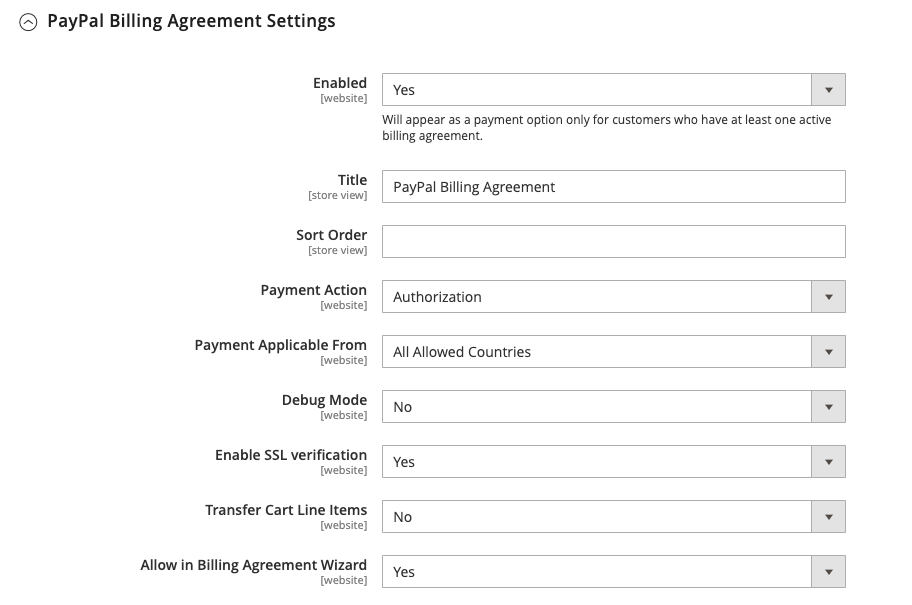 Billing Agreement Settings - PayPal Payments Standard
Billing Agreement Settings - PayPal Payments Standard -
Set Enabled to
Yes. -
Enter a Title to identify the PayPal Billing Agreement method during checkout.
-
If you offer multiple payment methods, enter a number in the Sort Order field to determine the sequence in which Billing Agreement appears when listed with other payment methods during checkout.
-
Set Payment Action to one of the following:
AuthorizationApproves the purchase and puts a hold on the funds. The amount is not withdrawn until it is “captured” by the merchant. SaleThe amount of the purchase is authorized and immediately withdrawn from the customer’s account. -
Set Payment Applicable From to one of the following:
All Allowed CountriesCustomers from all countries specified in your store configuration can use this payment method. Specific CountriesAfter choosing this option, the Payment from Specific Countries list appears. To select multiple countries, hold down the Ctrl key (PC) or the Command key (Mac) and click each one. -
To record communications with the payment system in the log file, set Debug Mode to
Yes.The log file is stored on the server and is accessible only to developers. In accordance with PCI Data Security Standards, credit card information is not recorded in the log file.
-
To enable SSL verification, set Enable SSL verification to
Yes. -
To display a summary of each line item in the customer’s order on your PayPal payments page, set Transfer Cart Line Items to
Yes. -
To allow customers to initiate a billing agreement from the dashboard of their customer account, set Allow in Billing Agreement Wizard to
Yes.
Settlement Report Settings
-
Expand
 the Settlement Report Settings section.
the Settlement Report Settings section.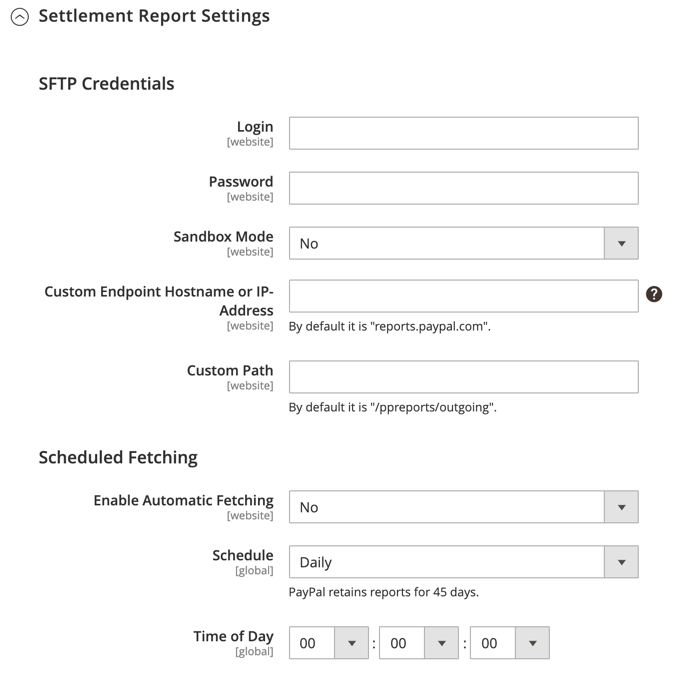 Settlement Report Settings - PayPal Payments Standard
Settlement Report Settings - PayPal Payments Standard -
For SFTP Credentials, do the following:
-
If you have signed up for the PayPal Secure FTP Server, enter the following SFTP login credentials:
- Login
- Password
-
To run test reports before going live with Express Checkout on your site, set Sandbox Mode to
Yes. -
Enter the Custom Endpoint Hostname or IP Address.
By default, the value is:
reports.paypal.com -
Enter the Custom Path where reports are saved.
By default, the value is:
/ppreports/outgoing
-
-
To generate reports according to a schedule, complete the Scheduled Fetching settings:
-
Set Enable Automatic Fetching to
Yes. -
Set Schedule to one of the following:
DailyEvery 3 DaysEvery 7 DaysEvery 10 DaysEvery 14 DaysEvery 30 DaysEvery 40 Days
PayPal retains each report for 45 days.
-
Set Time of Day to the hour, minute, and second when you want the reports to be generated.
-
Frontend Experience Settings
The Frontend Experience Settings give you the opportunity to choose which PayPal logos appear on your site, and to customize the appearance of your PayPal merchant pages.
-
Expand
 the Frontend Experience Settings section.
the Frontend Experience Settings section.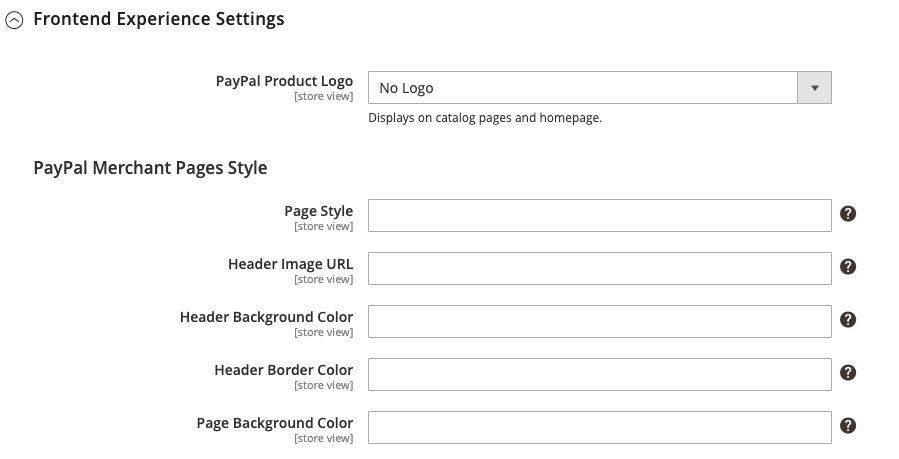 Frontend Experience Settings - PayPal Payments Standard
Frontend Experience Settings - PayPal Payments Standard -
Select the PayPal Product Logo that you want to appear in the PayPal block in your store.
The PayPal logos are available in four styles and two sizes:
No LogoWe Prefer PayPal (150 x 60 or 150 x 40)Now Accepting PayPal (150 x 60 or 150 x 40)Payments by PayPal (150 x 60 or 150 x 40)Shop Now Using PayPal (150 x 60 or 150 x 40)
-
To customize the appearance of your PayPal merchant pages, do the following:
-
Enter the name of the Page Style that you want to apply to your PayPal merchant pages:
paypalUses the PayPal page style. primaryUses the page style that you identified as the primary style in your account profile. your_custom_valueUses a custom payment page style, which is specified in your account profile. -
For Header Image URL, enter the URL of the image that you want to appear in the upper-left corner of the payment page. The maximum file size is 750 pixels wide by 90 pixels high.
PayPal recommends that the image be located on a secure (https) server. Otherwise, a browser may warn that the page contains both secure and nonsecure items.
-
To set the color for your pages, enter the six-character hexadecimal code, without the
#symbol, for each of the following:Header Background Color Background color for the checkout page header. Header Border Color Color for two-pixel border around the header. Page Background Color Background color for the checkout page and around the header and payment form.
-